December 28, 2009
Lawrence Lee
A very nice Flickr group featuring the stained glass of Lawrence Lee (b.1909).
Here are 2 striking details from St John the Baptist Church, Bisley, Surrey, England. Curiously, there are no full panel shots on which to compare. [wrong! see update below]
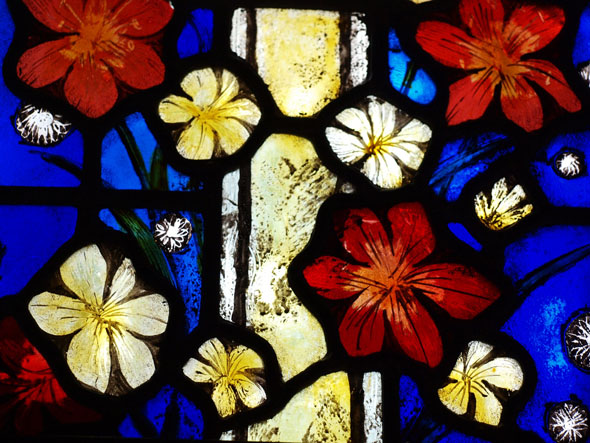
both images are via creative commons license from the Lawrence Lee flickrset of auntie_p, who is the main contributor to the Lawrence Lee Flickr group.
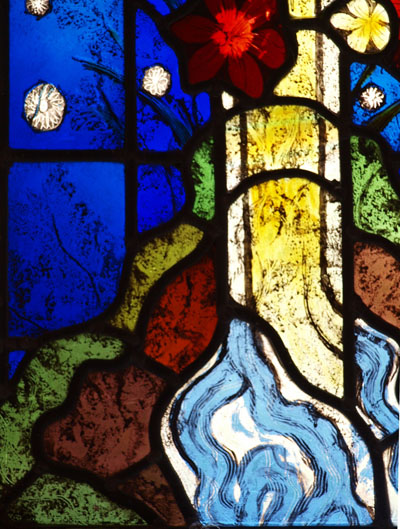
In the USA, Lawrence Lee is best known for the book he co-wrote with George Seddon, and Francis Stephens, called simply "Stained Glass". It is, in my opinion, the best introductory book on stained glass history. Well done all around - illustrations, photographs, general selection of sites, and overall structure. No initial introduction comes close to the quality of this book.
In my opinion, this is a must for any serious student of the art and technique of stained glass, especially any beginning student.
The cover of my own well worn copy of 'Stained Glass'.
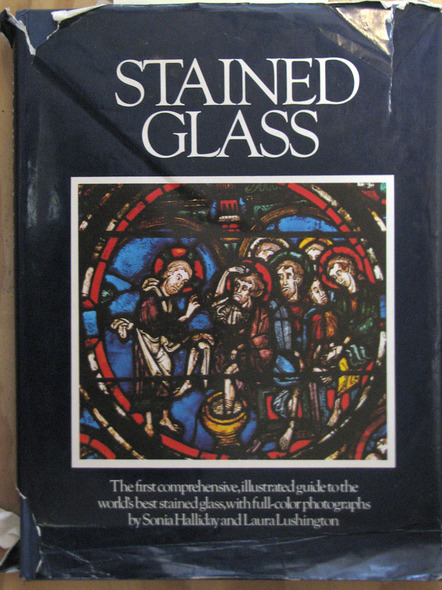
Images or previews of the contents are hard to find, mainly due to the book's size, which is unusually large, at 14 ½" high by 11" wide. So, I quickly cobbled together this image of the York Minster page spread to give an example of one of its 'Cathedral' pages. There are other similar spreads for Chartres, Notre Dame, Toledo and others.
Click on the link or image to see a high resolution 'Zoomified' version of the Minster Spread.
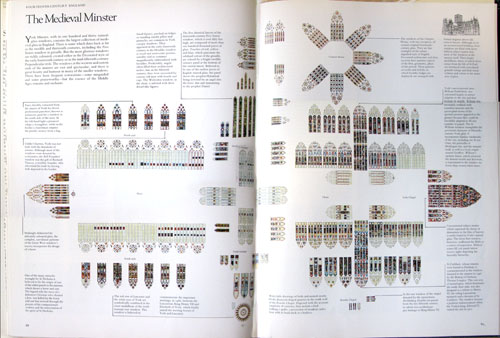
Though out of print, it's surprisingly easy to find good inexpensive copies of the book. As of this writing, the second edition from 1984 can be purchased through Amazon for as little as $1.39, plus $3.99 for shipping. Also, a quick search for Stained Glass at ALibris also brings up used copies starting at $2.
[update January 22, 2010 - heard from flickrite Auntie_P, who points out that there is, in fact, a full shot of the Bisley window in the Lawrence Lee stained glass group pool. Here is the full shot...

She also pointed out to me that this is part of a larger project of gathering the photos of Lawrence Lee's work, including Lee's own photographs and sketches. Big project. Good Luck with the venture!!}
December 26, 2009
Secular Window Saturday 2 - Sundials
Gecko Dial, circa 2003-2005
click to see larger image in new window

Part of the Stained Glass Sundials by Carmichael Flickrset, which is part of the larger Sundials by Carmichael's photostream, by Arizona Sundial Creator John Carmichael.
Make sure to check out Carmichael's Stained Glass Sundials website. It includes an incredibly rich archive of historical stained glass sundials. The annotations are copious and well organized. For example, this is the The Ambras Castle Dial, a Swabian sundial made in 1550, from the page for the 16th and 17th century stained glass sundials.
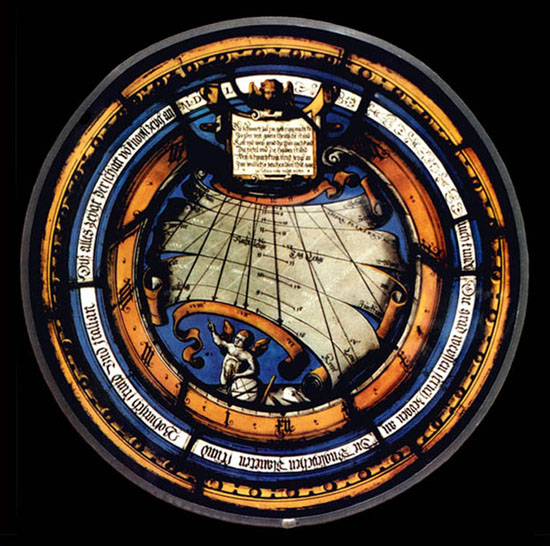
Another stained glass site worth a good long browse.. or two.
December 24, 2009
Lansdowne Church, Glasgow
Merry Christmas to all in the Christian world!
I just received a Christmas card with a photo of this window from Lansdowne Church, in Glasgow, Scotland. It's considered to be some of the best work of the Scottish stained glass designer, Alf Webster.
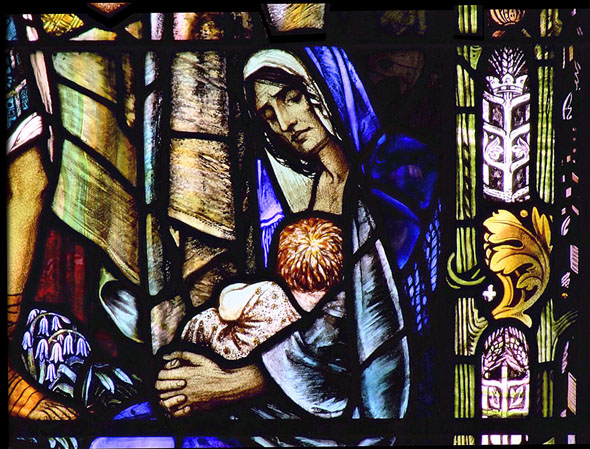
I don't think I've seen any other breastfeeding scenes in stained glass. There must be some. I know that breastfeeding scenes were fairly common in Medieval art, though I've never seen one in a Medieval stained glass window.
Some Gothic art with breastfeeding scenes can be seen on the www.art-breastfeeding.com website.
While this image is certainly appropriate for the Christmas season, being a mother and child, it is not from a nativity scene, nor is it even Mary and Jesus apparently. I've only seen it referred to as "Jesus in a Crowd".
The full panel with the mother and child image in context -
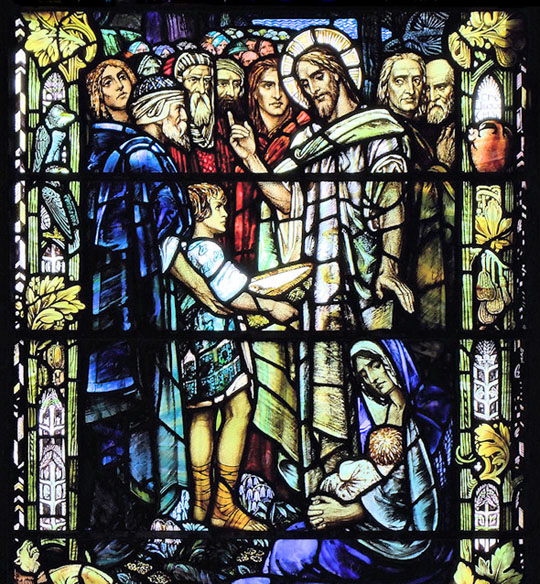
photo via Creative Commons license from Tom_Clearwood's Lansdowne Flickrset, part of the Lansdowne Flickr Pool. Worth a good long browse. Many nice details of the windows, and it's a good cause as it's all part of the conservation effort to save the Lansdowne church as a community center, while keeping all the windows in their original place.
December 19, 2009
Secular Window Saturday - Museum of the History of Science
Arms of The Royal College of Physicians Window from the Museum of the History of Science, Oxford, England.
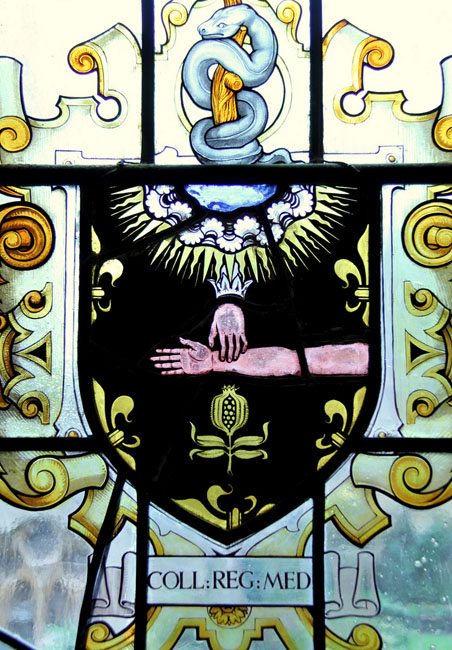
via creative commons license from flickrite kotomigd
See more windows and other images from this "Museum of the History of Science, Oxford" Flickr Group Pool. It includes almost 700 images from the museum, including more than 25 photos of the stained glass. Fascinating stuff.
December 15, 2009
Sanford Bray
Last August, I posted this patent issued to Sanford Bray in 1886 for what we now know as the copper foil technique. A man named Patrick Horn saw that post and sent me some further information on Bray. Patrick found it while doing genealogical research. I thought I would put the info and documents out and see if anyone is interested in them. It's all a bit of a puzzle, but the pieces from Patrick do seem to fit, even if they still leave a very incomplete story.
Joining Glass Mosaics (links to full patent on Google Patents)
by Sanford Bray, Boston, MA
patent # 349424, issued 1886
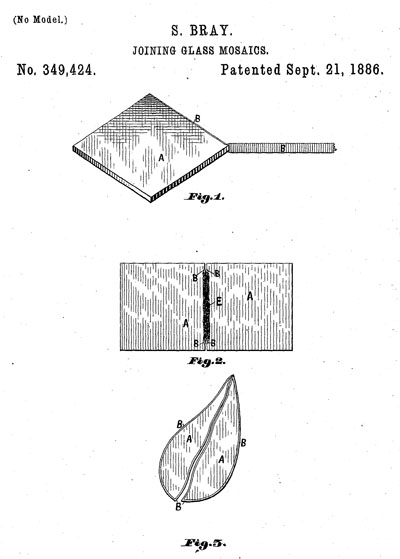
The most interesting and surprising fact is that this patent was issued to Bray when he was only 27 years old.
The images from Patrick Horn, plus some text, and a little comment after the fold...
from a biographical entry on John Bradley Hudson Jr., a painter who was Sanford Bray's father-in-law. -
click to enlarge in new window
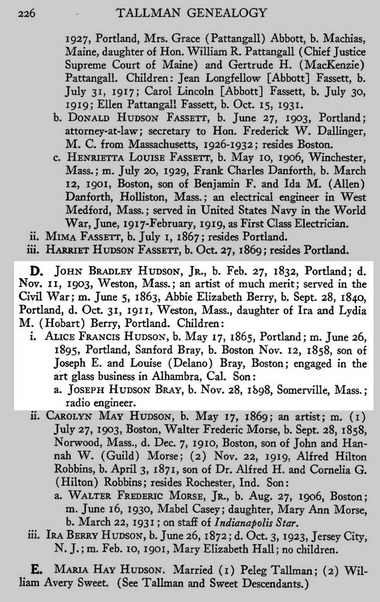
1880 Census Document with Sanford and his father and mother.
click to enlarge in new window
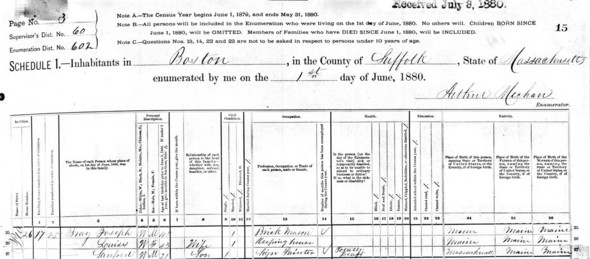
Sanford was 21 in 1880 and is listed as a sign painter. The most surprising thing in this census entry is that Sanford is listed as 'totally deaf'. No other document lists this.
1900 Census document - clipped to show only the Bray and Hudson families
click to enlarge in new window
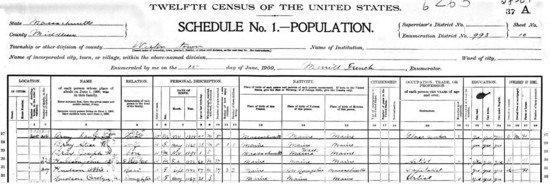
1930 Census document - clipped to show only the Bray info
click to enlarge in new window

Painting by John Bradley Hudson Jr.
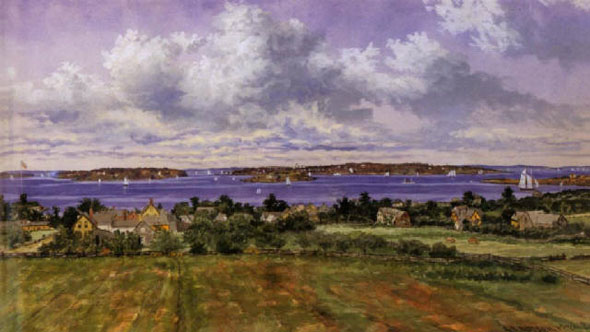
Portrait of John Bradley Hudson Jr.
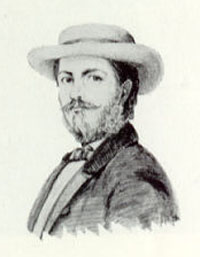
Los Angeles Directory, 1937, mentioning Bray, his wife and son
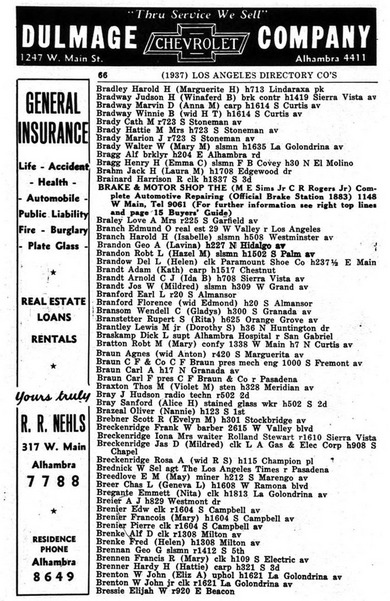
This is the text info I got from Patrick, from census records mostly.
Patrick Horn - dec 8
I still don't know when Sanford died, but I found him up until 1943 (age 85) in Alhambra, Los Angeles Co., California. I found old U.S. City Directories with him, his wife (Alice Francis Hudson) and his son (Joseph Hudson Bray). The last one which stated his occupation (Stained Glass Worker) was from 1937.
Sanford Bray
Birth - 12 Nov 1858, Boston, Suffolk, Massachusetts
Death - California
Parents & Siblings
Father - Joseph Bray (1833-)
Mother - Louisa Delano (1831-1890)
Spouse & Children
Spouse - Alice Francis Hudson (1865-1951)
Son - Joseph Hudson Bray (1898-)
1886
21 Sep - Age: 27 - U.S. Patent
Boston, Suffolk, Massachusetts
Patent for Joining Glass Mosiacs
1888 - Age: 30
Company Purchased By Tiffany's
no source
1895 - 26 Jun - Age: 36
Marriage to Alice Francis Hudson
Portland, Cumberland , Maine
1910 Age: 52 Residence
Waltham Ward 3, Middlesex, Massachusetts
source 1910 United States Federal Census
1920 - Age: 62 Residence
Waltham, Middlesex, Massachusetts
source 1920 United States Federal Census
1930 - Age: 72
Alhambra, Los Angeles, California
Occupation: Artist
source - 1930 United States Federal Census
The pieces do fit in with this Sanford Bray being the one who had the patent issued to him in 1886, but some questions remain.
Did Tiffany indeed purchase the patent in 1888? I have only ever heard that Bray sold his patent to Tiffany in 1888. I've never seen or heard of any documentation to confirm this. I'd be curious to know what the Tiffany scholars think of this.
There is also the question - If Sanford Bray remained working in stained glass all these years, where is the evidence of his work? Since he is listed, variously, as a 'stained glass worker' and a 'lead glazer' rather than as a stained glass artist, it would be easy to assume that he was not a designer, and therefore no designs of his would be around. But maybe not. Nevertheless, he either worked for other studios or had his own studio all these years. What studios? What kind of stained glass work did he do? There is no evidence of this.
I suspect the idea of who is Sanford Bray will remain an open puzzle for some time. I'll update if I get further info.
December 08, 2009
New Medieval Galleries at the V&A
The reviews are coming in for the newly reopened Medieval and Renaissance Galleries at the Victoria and Albert Museum (commonly known as the V&A) in London, England. This review of the V&A's Medieval & Renaissance Galleries in the Telegraph is pretty typically glowing.
But I'm not so sure. The collection is amazing, truly one of the very best in the world. But from the photos I've seen of the exhibition space, something strikes me as wrong.
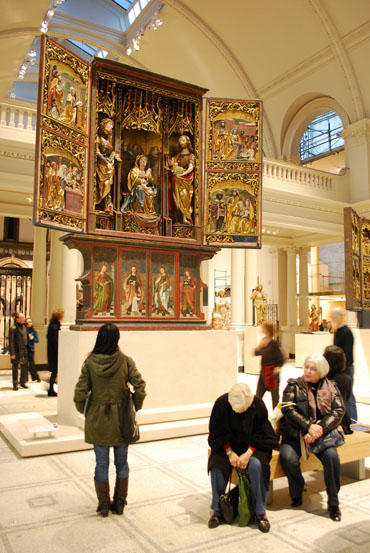
Flickrite Sam the Sham and the Photos
My first uneasy impression - Why all the white?
A minor rant and a few more images below the fold...
Butterfly Collection versus Theme Park Ride
The V&A collection of medieval art and stained glass is one of the best in the world. But I do wonder if the reviewers are praising the collection and not the exhibition. This video from the Guardian was the first thing I saw of it and it shows lots of the white walls in a very brightly lit space.
My concerns about the white space started to clarify when I read this article from the Guardian website, with the curious title of In this mist of antique loveliness, the object is all. For history go elsewhere. In the article Simon Jenkins praises the exhibition while also pointing out the issue of context. He contends that the V&A has a fear of putting the art works in any kind of context. That nay context would turn the whole exhibit into a theme park ride, tagging it with the dreaded title of 'Disneyland'.
I contend that the V&A has gone too far in the other direction and the whole thing comes off as a terribly stark and sterile, brightly-lit butterfly collection.
In the end, Simon Jenkins suggests it's not that important and his only response is 'museums can't do everything'.
I would argue that surely there can be some kind of compromise between the butterfly collection approach and the theme park ride approach. Maybe even start by getting rid of the harsh snarky metaphors.
One area where I would hope there could be compromise is with light levels. In the new modern approach, the light levela seem way too high. Can that be toned down without losing integrity?
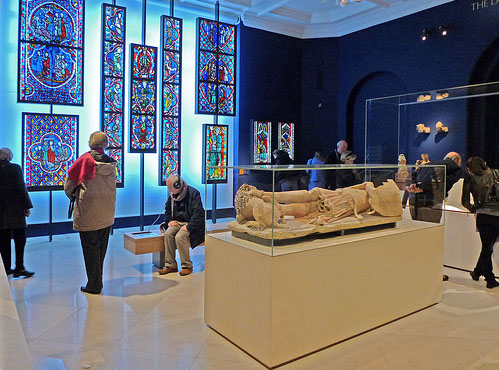
Flickrite Where the Art is
This lightbox setup for the stained glass is especially galling. To see the amazing V&A collection of stained glass just popped in front of a big single stark white plexiglass light box chills my spine. At least some of the stained glass is placed in individual light boxes so you are not seeing the panels with a stark white light surrounding them, though there is still a stark white wall. Was there any attempt to find a way to display this incredible collection in natural light?
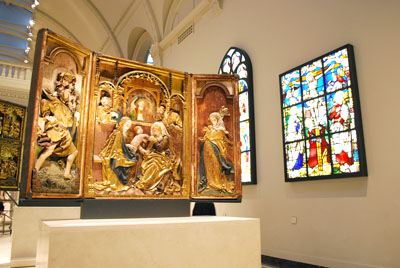
Flickrite Sam the Sham and the Photos
Obviously, I reserve final judgement on seeing the new galleries in person, but I'm concerned that the concept of how to display these works of art was ill-conceived. From what the Jenkins articlel suggest, it's from the fear of looking like a theme park. My own hunch is that 'light, bright and airy' modern museum spaces are easier to sell than dimly lit medieval spaces in our day and age. So they fit the medieval collection to what people expect in a modern museum, which means light and airy atrium spaces.
Personally, I wish they had designed the space to fit the needs of the collection, not the marketplace.
December 07, 2009
Buzz is good
Joseph Cavalieri is catching some blogosphere buzz over his Simpsons Series.
December 06, 2009
Google Patents 4 - "Dynamic Stain Glass Window"
As proof that people are still out there inventing new stained glass related technologies, there is this very recent patent. So recent that it's only a patent application, from May of 2009, just over 6 months ago.
DYNAMIC STAIN GLASS WINDOW
Don M. Ferris
Application number: 12/471,438
Publication number: US 2009/0233030 A1
Filing date: May 25, 2009
The idea is for a mechanism to revolve one circular stained glass window in front of another stationary stained glass window, to create some kind of light pattern. It's not specified if that light pattern is projected or only visible looking at the panels themselves. Even with the photos of the prototype (figures 11-13) it's a little hard to imagine what the effect is. The prototype appears to have a stationary window with square bevels, and a moving panel with an abstract design. I've never heard of Don M. Ferris and the only thing that comes up on a Google search is the patent.
I've noted before about how patents often patents are written in a way that they are hard to read. Kind of like that last sentence.
I thought it might be because most of the patents I've looked at are more than a hundred years old. But the same applies to this recent patent application. There must be something about patent applications that brings out the craziest language in people. For example, this is the first line of the 2009 patent application -
1. A dynamic stain glass window assembly utilizing a fixed traditional lead came stain glass window and a moveable traditional lead came stain glass window creating a moving light pattern to be displayed comprising in cooperative combination:
Maybe it would be a good idea if there were a requirement to read Strunk and White's 'Elements of Style' before applying for a patent.
December 02, 2009
Google Patents 3 - Pseudo Stained Glass or Proto-Fused Glass?
Call these "stained glass patent curiosities" - all of these either appear to look like stained glass or call themselves stained glass. Yet all of these patents seem to be for a "stained glass-like" appearance that is created with a form of melting glass into a metal matrix or fusing of the flat glass into a mold.
Manufacture of Decorative Glass Products,
Hollon F. Miles,
Chicago Illinois,
Patent number 287768, issued 1883
This appears to be at first glance a standard stained glass window, even in the cross sections. Only the bulging of the glass in figures 5,6,7 look unusual. In fact it is a method for melting glass into a pre-existing metal matrix. No details, like type of metal, etc. Hard to imagine this working under any circumstance, what with issues like contraction and expansion to deal with. I've never heard of or seen an example of any stained glass from that time constructed in this manner.
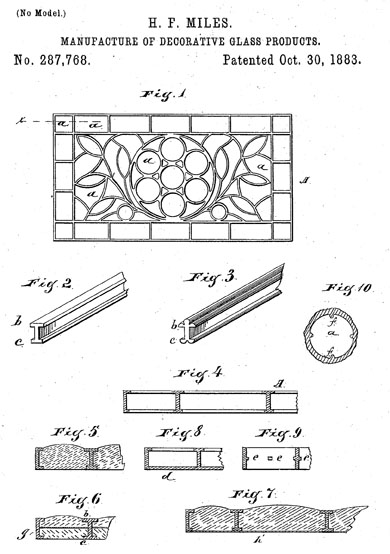
Manufacture of Stained Glass for Windows, etc.,
ARTHUR ROGER CARTER AND HENRY CLIFFORD HUGHES,
Patent number 477990, issued June 1892
The patent states that Arthur Roger Carter is a tobacco-manufacturer and Henry Clifford Hughes a stained glass manufacturer, both from London, England.
As far as I can tell from the arcane language, this is a straightforward fusing process, though done in a kind of mold made of platinum (used for its inoxidizabilty), mica, iron and fire-clay. There appears to be no attempt to simulate lead lines, though there is a mention of being able to fire the glass afterwards "with vitreous enamel color".
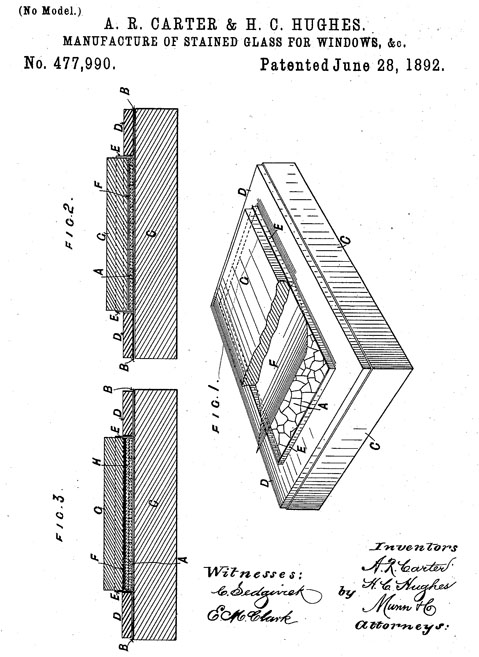
it's a little more legible sideways
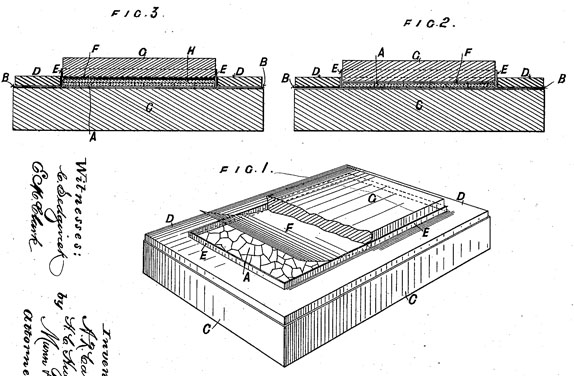
Manufacture of Stained-Glass Panels,
Henry Clifford Hughes,
Patent number 519186, issued 1894
Specifically an elaboration of the last patent, as this is the same H.C. Hughes but without the tobacco-manufacturer. Again, it still seems to be for a kind of fusing process, where pieces of glass are placed on mica (instead of platinum) and kiln fired. This patent is a little clearer in its language, though not much. The pieces of glass are laid side by side, covered with a vitreous flux, and 'welded' together, including the idea of 'pressing on the glass joints with an iron tool' while at the 'welding point'. After cooling, the piece is then painted with 'vitrifiable enamel colors' and then covered with a piece of 'white glass' (I assume he means 'clear glass' in this case) and then 'welded' again to form the final stained glass panels.
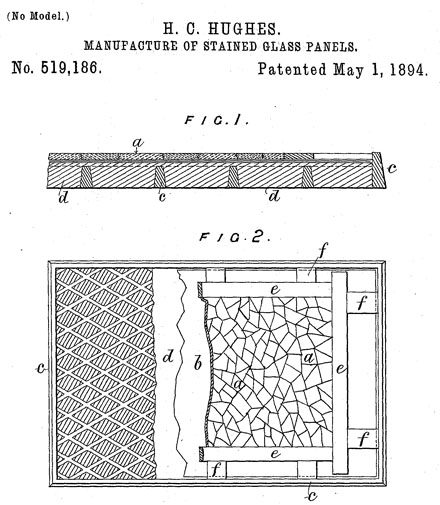
Of course, you look at these patents and it makes you think - how is this easier, cheaper, or more effective than a traditionally made stained glass window.?
Then again, it is true that these patents could be seen as about 100 years ahead of their time, just waiting for the fusing/kiln-fired flat glass movement to happen.